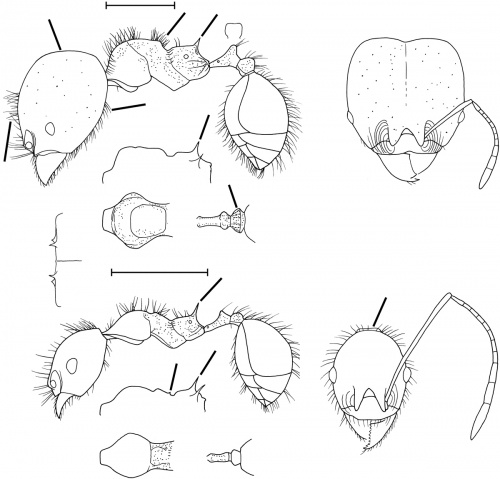Pheidole pepo
| Pheidole pepo | |
|---|---|
| Scientific classification | |
| Kingdom: | Animalia |
| Phylum: | Arthropoda |
| Class: | Insecta |
| Order: | Hymenoptera |
| Family: | Formicidae |
| Subfamily: | Myrmicinae |
| Tribe: | Attini |
| Genus: | Pheidole |
| Species: | P. pepo |
| Binomial name | |
| Pheidole pepo Wilson, 2003 | |
Collected in spiny bamboo (Guadua) forest. (Wilson 2003)
Identification
See the description in the nomenclature section.
Keys including this Species
Distribution
Only known from the type locality.
Latitudinal Distribution Pattern
Latitudinal Range: 2.705257° to -4.1°.
| North Temperate |
North Subtropical |
Tropical | South Subtropical |
South Temperate |
- Source: AntMaps
Distribution based on Regional Taxon Lists
Neotropical Region: Colombia (type locality), French Guiana.
Distribution based on AntMaps
Distribution based on AntWeb specimens
Check data from AntWeb
Countries Occupied
| Number of countries occupied by this species based on AntWiki Regional Taxon Lists. In general, fewer countries occupied indicates a narrower range, while more countries indicates a more widespread species. |

|
Estimated Abundance
| Relative abundance based on number of AntMaps records per species (this species within the purple bar). Fewer records (to the left) indicates a less abundant/encountered species while more records (to the right) indicates more abundant/encountered species. |

|
Biology
Castes
Nomenclature
The following information is derived from Barry Bolton's Online Catalogue of the Ants of the World.
- pepo. Pheidole pepo Wilson, 2003: 730, figs. (s.w.) COLOMBIA.
Unless otherwise noted the text for the remainder of this section is reported from the publication that includes the original description.
Description
DIAGNOSIS A large, yellow member of the tristis group, similar to Pheidole rotundiceps, Pheidole sphaerica and Pheidole subsphaerica, easily distinguished by the following traits.
Major: head greatly swollen; clypeus and mandibles reduced proportionate to the head; outline of head in full-face view almost completely devoid of pilosity; in side view, profiles of both anterior dorsal half and anterior ventral half of head capsule densely pilose, but profiles of posterior dorsal and ventral halves bare of pilosity; propodeal spines long and acute.
Minor: body slender; occiput narrowed, with nuchal collar; propodeal spines long and slender, i.e., needle-like.
MEASUREMENTS (mm) Holotype major: HW 1.78, HL 1.66, SL 1.02, EL 0.22, PW 0.84. Paratype minor: HW 0.64, HL 0.80, SL 1.06, EL 0.16, PW 0.44.
COLOR Major: head and appendages medium yellow; mesosoma, waist, and gaster yellowish brown.
Minor: concolorous dark yellow.
Figure. Upper: holotype, major. Lower: paratype, minor. Scale bars = 1 mm.
Type Material
COLOMBIA: Finca Los Guaduales, 10 km southwest of San José del Palmar, Rio Torito, Chocó, 800 m, col. Charles Kugler. Museum of Comparative Zoology
Etymology
Gr pepo, melon, alluding to the unusual head shape of the major.
References
- Wilson, E. O. 2003. Pheidole in the New World: A dominant, hyperdiverse ant genus. Harvard University Press, Cambridge, MA. (page 730, fig. major, minor described)
- Franco, W., Ladino, N., Delabie, J.H.C., Dejean, A., Orivel, J., Fichaux, M., Groc, S., Leponce, M., Feitosa, R.M. 2019. First checklist of the ants (Hymenoptera: Formicidae) of French Guiana. Zootaxa 4674, 509–543 (doi:10.11646/zootaxa.4674.5.2).
References based on Global Ant Biodiversity Informatics
- Franco W., N. Ladino, J. H. C. Delabie, A. Dejean, J. Orivel, M. Fichaux, S. Groc, M. Leponce, and R. M. Feitosa. 2019. First checklist of the ants (Hymenoptera: Formicidae) of French Guiana. Zootaxa 4674(5): 509-543.
- Leponce M., J. H. C. Delabie, J. Orivel, J. Jacquemin, M. Calvo Martin, and A. Dejean. 2019. Tree-dwelling ant survey (Hymenoptera, Formicidae) in Mitaraka, French Guiana, in Touroult J. (ed.), “Our Planet Reviewed” 2015 large-scale biotic survey in Mitaraka, French Guiana. Zoosystema 41 (10): 163-179.
